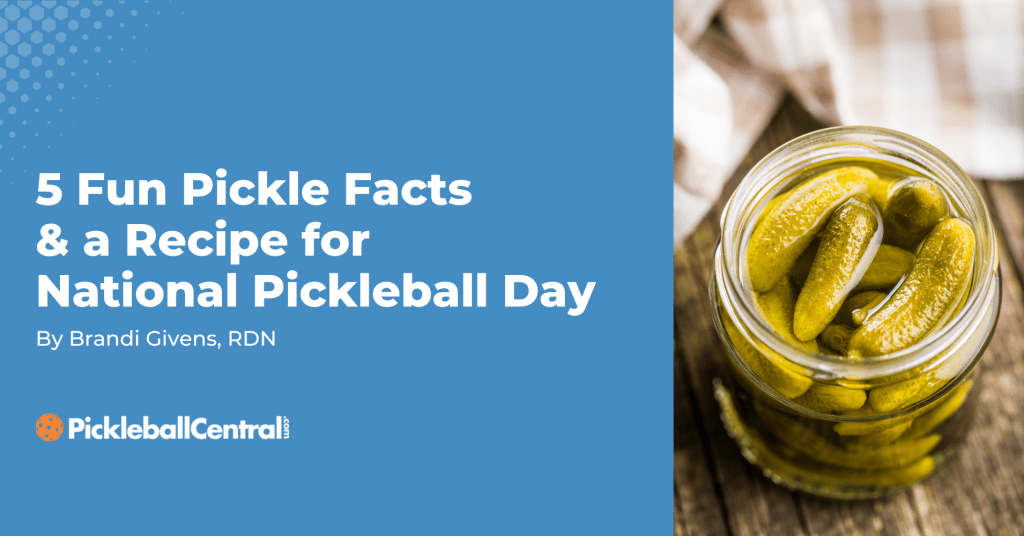By Brandi Givens, RDN
Ah, pickles. Where would our beloved game be without its tasty little namesake? While some sour sports think pickleball has an undignified brand, most fans are proud that our game is associated with this tangy veggie. Here are some fun facts about pickles that you may not know.
1. Pickles have quite the spicy history. According to the New York Food Museum, pickles have been around since about 2400 BC, likely originating in Mesopotamia. Since then, they’ve been relished by some very famous folks:
- Pickles are mentioned at least twice in the Bible.
- Cleopatra swore by them as her personal beauty secret.
- Amerigo Vespucci, America’s namesake, was a pickle peddler before he was an explorer.
- Columbus carried pickles for his crew on his long voyages and grew cucumbers in Haiti for pickling.
- Shakespeare alluded to them in several of his plays and coined the phrase, “In a pickle.”
- And who could forget Pickles the Dog, who the pickleball founders named after our sport.
Of course, most relevant to pickleball is the term pickle boat. In competitive rowing, this boat holds the hodge-podge of athletes thrown together after the elite crews are chosen. Pickleball was named after the pickle boat because it’s a fun mix of other paddle sports.
2. Americans eat an average of 8.5 pounds of pickles. They’re a popular tournament snack among pickleball pros including one of my favs, Brian Ashworth, who especially enjoys his Claussen dills.
3. Pickles can help fight dehydration and may help players maintain the body’s electrolyte balance. The brine is high in sodium which leeches into the vegetable The cucumbers themselves contain some calcium and potassium. These electrolytes may be useful in maintaining mineral balance when players are sweating for over an hour. It’s important to stay ahead of electrolyte losses and consume the recommended amount of these minerals before their deficiencies become a problem.
Cucumbers are also naturally high in water. Eating juicy fruits and vegetables including pickles can contribute to your overall fluid intake and help keep you hydrated.
4. Pickle juice may help with athletic muscle cramps. In one study, the juice relieved athletes’ cramps in as soon as 15 minutes, which was faster than the placebo.
While some may think that it’s the electrolytes in the juice that help, this is unlikely because it takes longer than a few minutes to absorb electrolytes into the body. Scientists believe instead that it’s a nerve reaction to the strong vinegar that helps relieve the cramps.
5. Some pickles are probiotic foods, or foods rich in active cultures of beneficial bacteria. These helpful microbes can contribute to a healthy digestive system, which leads to a healthier body overall.
Not all pickles are the same, however. For probiotic power, you want to look for fermented pickles made from salt-based brine, which are found in the refrigerated section of major grocery and health food stores. The shelf stable pickles that we usually buy are generally made with a vinegar base and are pasteurized, so there are no living probiotic bacteria in them.
If you enjoy spending time in the kitchen (the other kitchen), pickles can be surprisingly fun and easy to make. Here’s an easy refrigerator recipe to share with your favorite court buddies.
Basic Refrigerator Pickles
This easy recipe can be adapted to your own flavor preferences by adding your choice of fresh or dried spices. Start with four, clean, pint-sized canning jars with lids. For extra food safety, you can boil the empty jars in water for two minutes before filling them.
Ingredients:
-8 cups sliced pickling cucumbers
-Up to two tablespoons per jar of add-ins like fresh garlic, dill, jalapeno peppers, dried chilis, peppercorns, or mustard seed
For Brine:
-3 cups vinegar of choice like white, apple cider, or balsamic (must be 5% acidity or higher)
-3 cups water
-3 tablespoons pickling salt
-2 tablespoons sugar
Directions:
Place washed and sliced cucumbers in four clean pint jars. Add up to 2 tablespoons per jar of your favorite spices. Stir together remaining brine ingredients in a large pot and bring to a full boil for 2 minutes; let cool. Pour evenly over jarred cucumbers and store immediately in fridge. Pickles will be ready to eat after marinating for 1-2 days and will keep in the fridge for up to 2 weeks. Enjoy!
Resources:
Person, David. 2021. Untitled Document. Independently Published. http://www.nyfoodmuseum.org/_ptime.htm
Miller, Kevin C., Gary Mack, and Kenneth L. Knight. 2009. “Electrolyte and Plasma Changes after Ingestion of Pickle Juice, Water, and a Common Carbohydrate-Electrolyte Solution.” Journal of Athletic Training 44 (5): 454–61.
Miller, Kevin C., Gary W. Mack, Kenneth L. Knight, J. Ty Hopkins, David O. Draper, Paul J. Fields, and Iain Hunter. 2010. “Reflex Inhibition of Electrically Induced Muscle Cramps in Hypohydrated Humans.” Medicine and Science in Sports and Exercise 42 (5): 953–61.
Christian, Candice. 2020. “How to Make Quick Refrigerator Pickles.” April 29, 2020. https://foodsafety.ces.ncsu.edu/2020/04/how-to-make-quick-refrigerator-pickles/.
Bakuniene-Milanowski, Ann. 2020. “6 Health Benefits of Drinking Pickle Juice.” Cleveland Clinic (blog). December 31, 2020. https://health.clevelandclinic.org/6-health-benefits-of-drinking-pickle-juice/.
“Science of Pickles: Fascinating Pickle Facts.” n.d. Exploratorium: The Museum of Science, Art and Human Perception. Accessed July 12, 2022.https://www.exploratorium.edu/cooking/pickles/history.html.
Share Product:
SHARE THIS:


